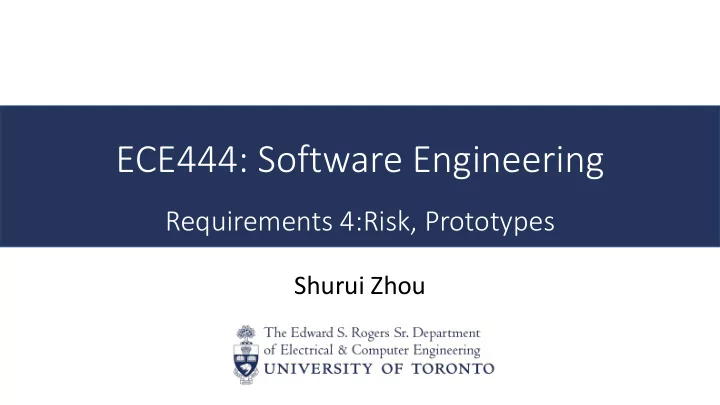

ECE444: Software Engineering Requirements 4:Risk, Prototypes Shurui Zhou
Learning Goals (Last lecture) • Understand tradeoffs of different documentation strategies • Document requirements using use cases and user stories • Evaluate the quality of a user story by INVEST
Product Requirement Document (PRD) 1. Goals 2. User Personas 3. User Stories 4. Functional Requirements 5. Non-Functional Requirements 6. User interaction and design 7. Questions 8. Out of Scope
Learning Goals • Understand how to organize user stories into story map • Understand risk and its role in requirements, specifically how it can be identified, analyzed, and then mitigated/handled in system design. • Low/high fidelity design
User Stories 8
User Story Example - Card
User Story Example - Conversation
User Story Example - Confirmation
Non-Functional Requirements Some might be global, some local • Security – All responses should be below 3 seconds • Performance – The wheel’s revolutions per minute should • Reliability be sampled 200 times per second to prevent • Usability aliasing effects • ... It is hard to reconcile global properties with agile principles
Non-Functional Requirements
Good Requirements
Story Mapping • Epic • Theme • Story
From goals to story maps
Risk Management 20
Risk
What are risks? • A risk is an uncertain factor that may result in a loss of satisfaction of a corresponding objective For example… • System delivers a radiation overdose to patients (Therac-25, Theratron-780) • Premier Election Solutions vote-dropping “ glitch ”
How to assess the level of risk? • Risks consist of multiple parts: • Likelihood of failure • Negative consequences or impact of failure • Causal agent and weakness (in advanced models) • Risk = Likelihood x Impact
Aviation failure impact categories • No effect – failure has no impact on safety, aircraft operation, or crew workload • Minor – failure is noticeable, causing passenger inconvenience or flight plan change • Major – failure is significant, causing passenger discomfort and slight workload increase • Hazardous – high workload, serious or fatal injuries • Catastrophic – loss of critical function to safely fly and land
Risk assessment matrix • MIL-STD-882E https://myclass.dau.edu/bbcswebdav/institution/Courses/Deployed/TST/TST303/Stude nt_Materials/Student%20Lessons%20%28PDF%29/L12S-RIO/Lesson%20Material/MIL- STD%20882E%20%28Extract%29
Risk Mgmt: Waterfall vs Agile • Longer development and planning • Short development cycles and quick delivery cycle • Testing is part of the development cycle • Business people are often part of the team • In waterfall projects: Testing at the which reduces risks end of the project • High responsiveness to changes • Less responsive to changes • Most frameworks do not prescribe risk management processes and techniques which • Prescribed comprehensive requires the project team to select and adapt processes to identify, assess and adequate measures review risks and assign risk responses
Risk Response Strategies
Risk analysis example (Time Keeper) Risk Probability Impact Solution 1 Application Low Medium Introduce Long-term crashes stability test 2 Inappropriate Medium Low Adjust auto-generated auto- schedule manually scheduling 3 Outdated Low Low Ignore integration
Prototypes, Mockups, Stories
Product Requirement Document (PRD) 1. Goals 2. User Personas 3. User Stories 4. Functional Requirements 5. Non-Functional Requirements 6. User interaction and design 7. Questions 8. Out of Scope
How should the product look?
High- vs low- fidelity mockups
Wireframes, low, and high fidelity prototypes
Wireframe, Prototype, Mockup https://designmodo.com/wireframing-prototyping-mockuping/
Mockups, Prototypes, Stories • Humans: better at recognizing whether a solution is correct than solving the problem from a blank page. • Mock-ups/prototypes help explore uncertainty in the requirements. • Validate that we have the right requirements. • Elicit requirements at the “borders” of the system. • Assert feasibility of solution space. • Get feedback on a candidate solution. • “I’ll know it when I see it”
Rapid prototyping • Throw-away: developed to learn more about a problem, not intended for actual use. • Evolutionary: intended to be incorporated into the final product. https://images.app.goo.gl/D54VKKtS4Bpgob3W8
Requirement analysis System Design
Summary • User stories and story mapping • Risk analysis • Using prototypes to enhance discussions and decision making
Recommend
More recommend